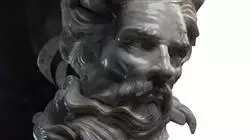University certificate
The world's largest faculty of information technology”
Introduction to the Program
Learn how to play with luminosity in your three-dimensional modeling and digital sculptures thanks to this online training"

The student will be able to delve into advanced concepts of lighting and photography in offline engines such as Arnold and V-Ray, as well as the post-production of renders to obtain a professional finish. In addition, students will learn advanced visualizations in realtime in Unity and Unreal, modeling in video game engines to create interactive scenographies and integrating projects in real spaces.
This is a Postgraduate certificate in online format that facilitates the professional and personal conciliation with the acquisition of new knowledge. The degrees designed by TECH are directly accredited, which means that it is not necessary to complete a project or end-of-course work in order to obtain the degree. In addition, it has the support of a faculty made up of the best professionals in the field.
Train yourself with the best professionals in a growing sector that requires professionals versed in 3D modeling lighting"
This Light Modeling in Postgraduate certificate contains the most comprehensive and up-to-date scientific program on the market. The most important features include:
- The development of case studies presented by experts in 3D Modeling and Digital Sculpture
- The graphic, schematic, and eminently practical contents with which they are created, provide scientific and practical information on the disciplines that are essential for professional practice
- Practical exercises where self-assessment can be used to improve learning
- Its special emphasis on innovative methodologies
- Theoretical lessons, questions to the expert, debate forums on controversial topics, and individual reflection assignments
- Content that is accessible from any fixed or portable device with an Internet connection
Learn how to model in videogame engines to create interactive scenographies and integrate projects in real spaces with this Postgraduate certificate"
The program’s teaching staff includes professionals from the sector who contribute their work experience to this training program, as well as renowned specialists from leading societies and prestigious universities.
The multimedia content, developed with the latest educational technology, will provide the professional with situated and contextual learning, i.e., a simulated environment that will provide immersive training programmed to train in real situations.
This program is designed around Problem-Based Learning, whereby the professional must try to solve the different professional practice situations that arise during the academic year. For this purpose, the student will be assisted by an innovative interactive video system created by renowned and experienced experts.
Thanks to this degree you will be able to delve deeper into advanced concepts of lighting and photography in offline engines such as Arnold and V-Ray"

Take this degree in online mode and become an expert in light modeling in just 6 weeks"
Syllabus
This Postgraduate certificate in Light Modeling has been designed by TECH Global University, in order to develop a complete syllabus that responds to the needs of a demanding market of professionals with expertise in 3D modeling lighting. The content is developed along 10 subsections that cover from lighting with Arnold and V-Ray engines, to working with global lighting techniques based on realistic and non-photorealistic renders, as well as the essential exports with other engines and programs such as Unreal or Unity. The program also includes a section dedicated to advanced lighting techniques in video games, although the learning applies to any 3D modeling you want to work on.

A complete study plan adapted to the demands of a market demanding lighting professionals"
Module 1. Light Modeling
1.1. Offline Arnold Motors
1.1.1. Interior and Exterior Lighting
1.1.2. Application of Displacement and Normal Maps
1.1.3. Render Modifiers
1.2. Vray
1.2.1. Lighting Bases
1.2.2. Shading
1.2.3. Maps
1.3. Advanced Global Illumination Techniques
1.3.1. ActiveShade GPU Management
1.3.2. Optimization of Photorealistic Rendering Denoiser
1.3.3. Non-photorealistic Rendering (Cartoon and Hand Painted)
1.4. Visualización rápida de modelos
1.4.1. ZBrush
1.4.2. Keyshot
1.4.3. Marmoset
1.5. Postproducción de renders
1.5.1. Multipases
1.5.2. Ilustración 3D en ZBrush
1.5.3. Multipass en ZBrush
1.6. Integration in Real Spaces
1.6.1. Shadow Materials
1.6.2. HDRI and Global Illumination
1.6.3. Image Tracing
1.7. Unity
1.7.1. Interface and Organization
1.7.2. Import to Game Engines
1.7.3. Materials
1.8. Unreal
1.8.1. Interface and Organization
1.8.2. Sculpture in Unreal
1.8.3. Shaders
1.9. Modeling in Video Game Engines
1.9.1. Probuilder
1.9.2. Modeling Tools
1.9.3. Prefabs and Memory Storages
1.10. Advanced Lighting Techniques in Videogames
1.10.1. Realtime, Pre-calculation of Lights and HDRP
1.10.2. Raytracing
1.10.3. Postprocessing

In only 6 weeks and in a totally online format: the best training in Postgraduate certificate you will find in the academic market"
Postgraduate Certificate in Light Modeling.
Light modeling is a process used in computer animation and visual effects production to create the illusion of lighting in a scene. In this process, algorithms and programming techniques are used to simulate and calculate reflected, absorbed and emitted light in a scene.
Light modeling is divided into three main stages: light generation, matter simulation and image rendering. In light generation, the light source in the scene, such as the sun or a lamp, is established and its position, intensity and color are determined. In matter simulation, the appearance of objects in the scene is modeled and their properties, such as opacity, brightness and texture, are set. These properties affect how light interacts with objects in the scene. Finally, in rendering, the final image is generated using the light and matter information, and a variety of effects, such as shadows and reflections, are applied.
Techniques used in light modeling.
Ray tracing: this algorithm tracks the path of light as it reflects and refracts in the scene, resulting in a very accurate and realistic image.
Radiosity: this algorithm is used to model indirect light in a scene, such as light bouncing off walls.
Shadow mapping: this technique simulates the shadow cast by objects in the scene and is used to create more realistic light and shadow effects.
Global illumination techniques: these techniques are used to simulate light reflecting off the atmosphere and other objects in the scene, and are used to create realistic lighting effects in outdoor environments.
Light modeling is a process used in computer animation and visual effects production to create the illusion of lighting in a scene. This process uses algorithms and programming techniques to simulate and calculate light and matter in a scene, and can achieve very realistic and detailed visual effects in film production, video games and other forms of digital media.







